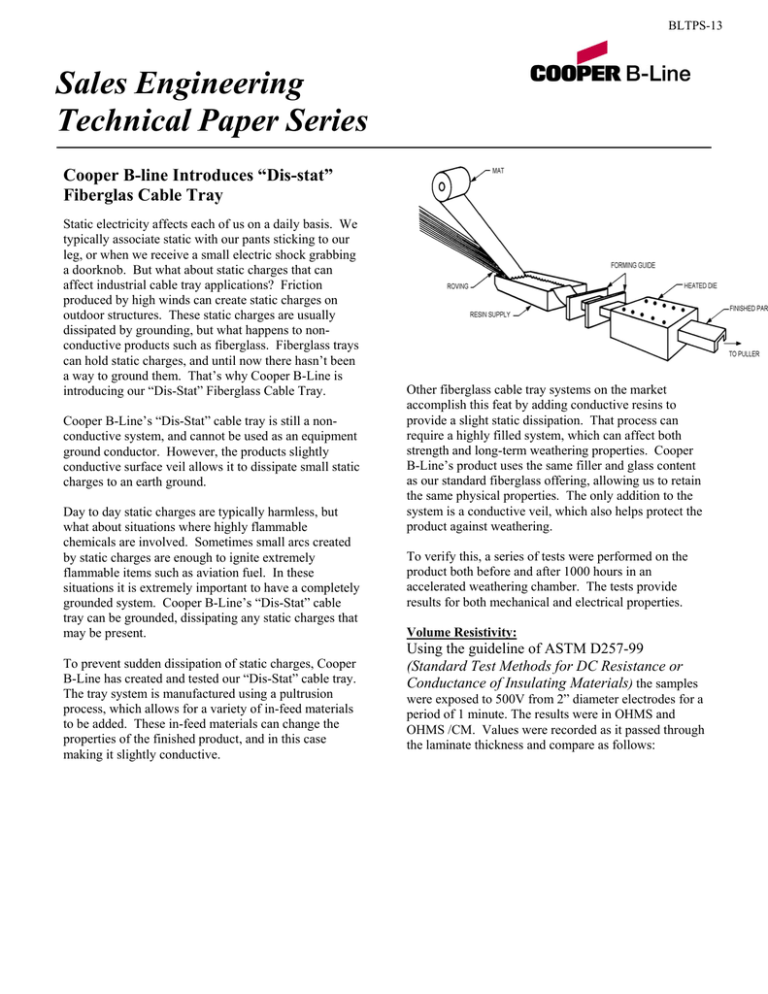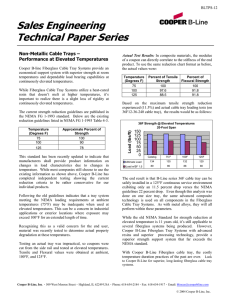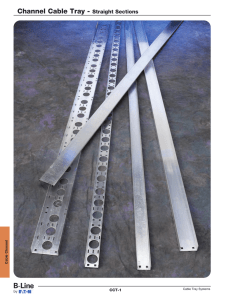Sales Engineering Technical Paper Series Cooper B-line Introduces “Dis-stat”
advertisement

BLTPS-13 Sales Engineering Technical Paper Series Cooper B-line Introduces “Dis-stat” Fiberglas Cable Tray Static electricity affects each of us on a daily basis. We typically associate static with our pants sticking to our leg, or when we receive a small electric shock grabbing a doorknob. But what about static charges that can affect industrial cable tray applications? Friction produced by high winds can create static charges on outdoor structures. These static charges are usually dissipated by grounding, but what happens to nonconductive products such as fiberglass. Fiberglass trays can hold static charges, and until now there hasn’t been a way to ground them. That’s why Cooper B-Line is introducing our “Dis-Stat” Fiberglass Cable Tray. Cooper B-Line’s “Dis-Stat” cable tray is still a nonconductive system, and cannot be used as an equipment ground conductor. However, the products slightly conductive surface veil allows it to dissipate small static charges to an earth ground. Day to day static charges are typically harmless, but what about situations where highly flammable chemicals are involved. Sometimes small arcs created by static charges are enough to ignite extremely flammable items such as aviation fuel. In these situations it is extremely important to have a completely grounded system. Cooper B-Line’s “Dis-Stat” cable tray can be grounded, dissipating any static charges that may be present. To prevent sudden dissipation of static charges, Cooper B-Line has created and tested our “Dis-Stat” cable tray. The tray system is manufactured using a pultrusion process, which allows for a variety of in-feed materials to be added. These in-feed materials can change the properties of the finished product, and in this case making it slightly conductive. Other fiberglass cable tray systems on the market accomplish this feat by adding conductive resins to provide a slight static dissipation. That process can require a highly filled system, which can affect both strength and long-term weathering properties. Cooper B-Line’s product uses the same filler and glass content as our standard fiberglass offering, allowing us to retain the same physical properties. The only addition to the system is a conductive veil, which also helps protect the product against weathering. To verify this, a series of tests were performed on the product both before and after 1000 hours in an accelerated weathering chamber. The tests provide results for both mechanical and electrical properties. Volume Resistivity: Using the guideline of ASTM D257-99 (Standard Test Methods for DC Resistance or Conductance of Insulating Materials) the samples were exposed to 500V from 2” diameter electrodes for a period of 1 minute. The results were in OHMS and OHMS /CM. Values were recorded as it passed through the laminate thickness and compare as follows: BLTPS-13 Volume Resistivity (10^8 Ohms/cm) (10^8 Ohms/cm) 1.5 1.5 1.45 1.4 1.35 1.4 Non-Weathered Weathered Therefore, it is proven that the product will maintain it’s electrical properties after ten years of outdoor exposure. Strength Properties: Coupons were also taken for the product and tested per ASTM D790. This test provided us with the mechanical strength characteristics of the product. The results of these tests are as follows: Flexural Strength: Flexural Strength (ksi) 80 69 (ksi) 60 40 66 40 20 0 Published NonWeathered Weathered Flexural Modulus: Flexural Modulus (psi) 4 3.4 (psi) 3 2 3.4 2.1 1 0 Published Non-Weathered Weathered These values reflect the overall rigidity of the tray system and can be directly related to tray loading and consequent deflection. Conclusion: As these products are used more and more in situations where static charges can be dangerous, it is important to keep safety in mind. This product can offer the same quality as our standard fiberglass offering, with the ability to ground the system and avoid safety concerns. As shown in the above test results our product maintains both its mechanical and electrical properties throughout its lifetime.





